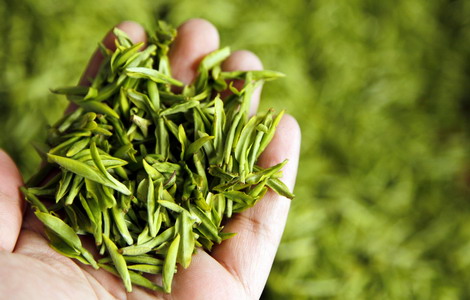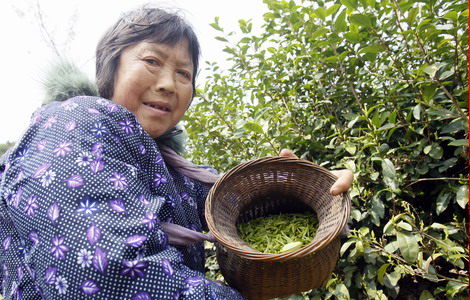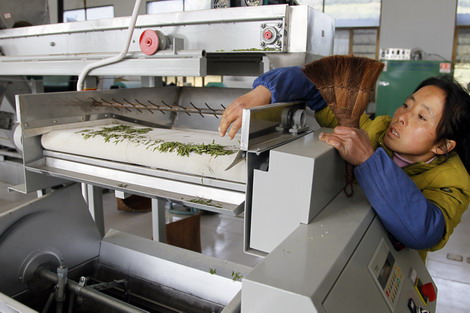 |
|
|
|
|||||||||
The first spring teas to reach the markets can fetch prices that have farmers singing all the way to the bank. Xie Yu and Zhang Jianming find out how modern technology is helping the farmers make this lucrative brew.
|
 |
|
The fresh Mingqian tea from Chun'an tea plantations. [Photo / China Daily] |
It is harvest time in Hangzhou for Mingqian tea, a kind of green tea picked and dried before the Qingming Festival, the period of pure brightness in spring when the Chinese sweep the tombs of their ancestors in a yearly mark of respect. This year, the actual day will fall on April 4. While most tea planters, pickers and traders are at their busiest now trying to harvest as much of the tea shoots as they can before Qingming, Shao Zongqing is enjoying his profits from the early tea he had already sold.
The manager of Chun'an Seedling Cultivation Center can relax because all the tea buds on his bushes have been harvested, dried and sold. He did not have to worry about the spring frost or sudden rains that may have destroyed the tender buds. His tea is grown in greenhouses.
Shao's tea was one of the earliest spring teas sold this year. The bids for the very first Mingqian tea topped 72,000 yuan ($11,400) per kilogram in February. His workers are now pruning the tea bushes to help them grow faster for next year's harvest.
"We'd finished working on all the early tea bushes, sold off all the processed tea leaves, and we can now focus on harvesting other kinds of spring teas. They are also very valuable before Qingming," Shao says.
He had managed to produce 200 kg of the Mingqian teas this year, and the average price he got was more than 10,000 yuan per kilogram.
Mingqian tea is known for its tender buds and rich fragrant bouquet, and it's valued for its quality.
However, the temperatures before Qingming are generally low and often unpredictable. The tea shoots are few, and they grow slowly. Few shoots actually meet the exacting standards that are set. They have to be plucked before they harden and mature, but must still be flavorful enough. Thus, Ming- qian tea is pretty rare.
Because of its value, tea producers have not stopped trying to bring forward the normal harvest time of the spring tea, catering to the Chinese tea drinkers' obsession for tasting the first buds of spring.
This commercial opportunity has stimulated experiments, many of them aided by modern technology.
Growing tea in the controlled climate of a greenhouse is no picnic. Many tea producers have tried the method in an attempt to force the bushes to set buds.
But while the greenhouse environment can prompt early budding of the tea, the buds tend to be weak and pale and do not have the aroma needed for a good infusion.
|
 |
|
Chun'an tea pickers work long hours for fresh tea leaves. [Photo / China Daily] |
To counter the weaknesses and improve the quality of their early teas, Shao and his companions completed many experiments on temperature, light, humidity and the acidity of soil - all crucial to tea growing.
After five years, they succeeded in bringing forward the harvest by a month. But what mattered most was that their tea buds were fat and vigorous with the requisite bouquet and taste that tea connoisseurs wanted - even after three brews.
"We used electric bulbs for added light, and liquefied carbon dioxide to accelerate photosynthesis so the tea grows faster."
Shao adds that no chemical fertilizer is used, only the organic residue from rapeseeds after the oil is pressed. This also keeps the soil acidity at around pH 6.0.
His early tea is named Qiandao Jade Leaves, meaning every leaf is green and precious as jade.
It needs a practiced connoisseur to tell the differences between early Qiandao Jade Leaves and top quality West Lake Dragon Well tea, or Xihu Longjing, the most renowned green tea in China.
Both are dried and roasted into yellowish green smooth, flat leaves.
Brewed in hot water, the early tea has a lighter amber hue with a brighter clearer infusion, a slight sweetness and lighter tannins.
Xihu Longjing is known for its roasted chestnut bouquet, while the early Jade Leaves combines the aroma of chestnut and newly sprouted spring buds. The only reservation is that the early tea is still a little weaker in taste and aroma.
"In my opinion, the quality of early Qiandao Jade Leaves is as good as the best Xihu Longjing," asserts Huang Xiaoping, secretary-general of the tea association in Chun'an county. "More important, its picking time is more than a month earlier, which allows the tea to monopolize the market before other teas are even ready for picking."
|
 |
|
Modern technology is employed in the tea production in Chun'an. [Photo / China Daily] |
In Yu Zheng's hillside tea plantations, over 150 tea pickers are plucking the terminal buds from the tea bushes.
Wei Hongmei, 38, a very experienced tea picker, says she would stand for over 10 hours a day, and can pick no more than two kilograms of fresh tea leaves.
Yu, her boss, worries constantly about the readiness of the tea shoots. Because of the low temperatures and constant rain in February, several tea varieties had not budded as expected. But as the weather warmed in March, they all suddenly sprouted at the same time.
Two kilograms of fresh leaves produce only 500 grams of tea. That would take about 10,000 buds.
"The tea has every reason to command a high price. I have to make sure the tea buds are picked and dried in time, or they will grow tough and decline in quality," Yu says, noting that he had to fight against time, bringing in all the pickers he could find. Even so, he could not catch up with the budding.
If he used the greenhouse early tea technology, Yu can stagger the picking of the tea, and start making profit earlier.
"Of course, if you can put the spring tea on market as early as possible, it can be more competitive," he says. He know that time is money where spring tea is concerned.
The only problem is money.
"Setting up a greenhouse with all the equipment costs over 15,000 yuan. It will not pay for itself in one year. I reckon it takes about three years to recover costs," Yu calculates. Even so, he plans to put aside 20 mu (1.3 hectares) for a pilot plantation this year, and see how it works.
Although the planting of early tea seems like very good business, the Chun'an authority is in no hurry to promote the idea.
"Early tea is good for expanding the name of tea produced in Chun'an, but the charm of tea has deep connections with tradition, and we have no intention of changing that," says Hu Duo, an official from the county bureau of agriculture.
In Hangzhou, although the picking has just started, tea activity has already been heating up. In a pre-sale auction of Xihu Longjing, the first batch of tea was auctioned for 180,000 yuan ($28,500) per 500 grams in mid-March.
Xihu Longjing is grown in a designated area around the Xihu Lake and nowhere else. The growing, picking and processing strictly follow traditional guidelines, very much like the controls imposed on viniculture.
Contact the writer at xieyu@chinadaily.com.cn.